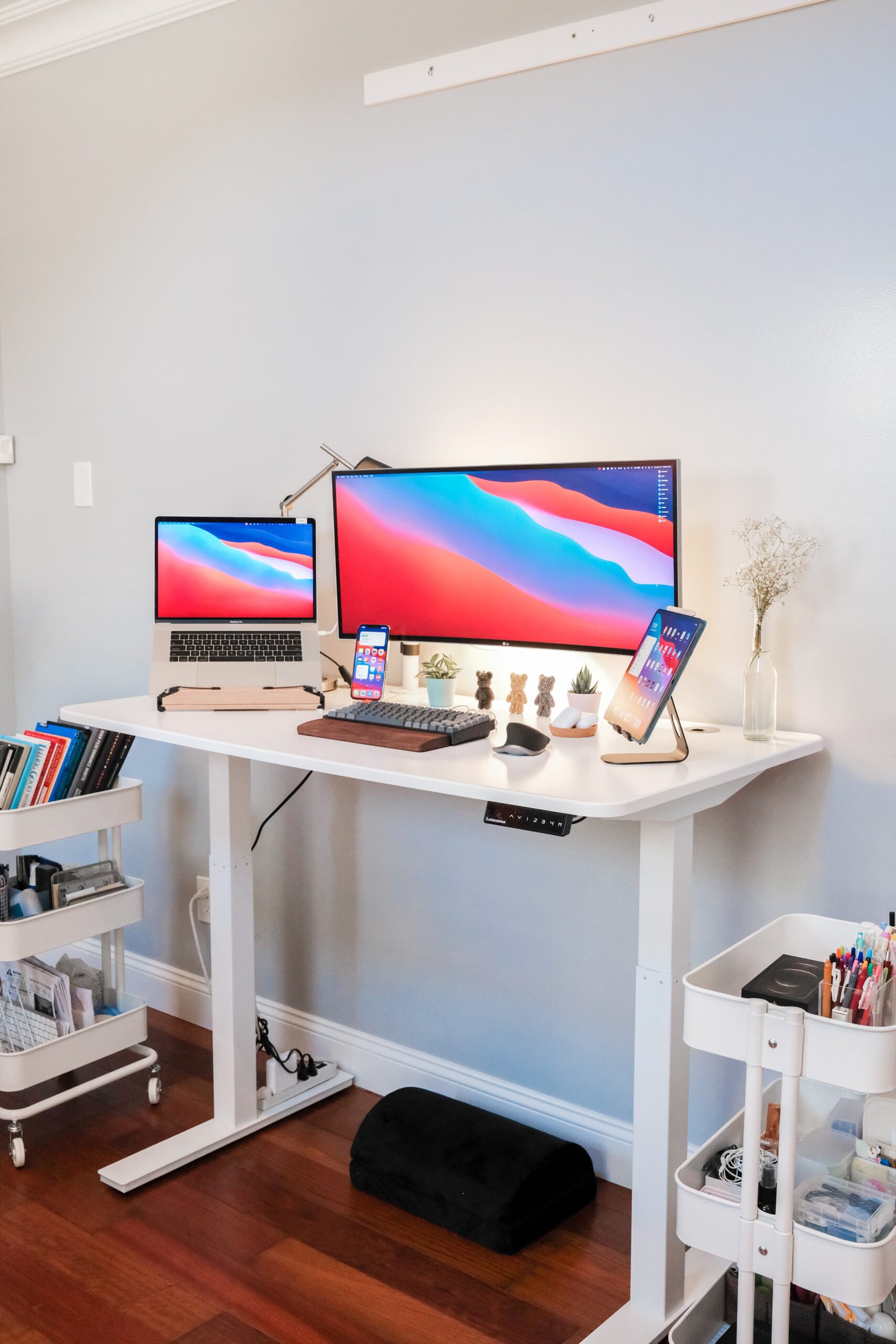So you’ve finally made the decision to try out a standing desk, but now you’re wondering how on earth to use it? Don’t worry, we’ve got you covered! In this article, we’ll walk you through all the essential tips and tricks to make the most out of your new ergonomic workstation. From ideal posture and height adjustments to incorporating movement breaks, we’ll help you effortlessly transition into a healthier and more productive work routine. Say goodbye to slouching and hello to a more energized and focused you!
Setting Up Your Standing Desk
Choosing the Right Height
When setting up your standing desk, the first step is to choose the right height. The ideal height is one where your elbows are at a 90-degree angle when resting on the desk surface. Stand comfortably with your shoulders relaxed, and adjust the desk height accordingly. It’s important to find a balance where you neither have to hunch over nor raise your arms too high.
Adjusting the Desk Surface
After determining the right height, it’s crucial to ensure the desk surface is at the correct level as well. The surface should be positioned parallel to your forearms when your elbows are bent at a right angle. This ensures you can work comfortably without straining your wrists or arms. Adjust the desk surface accordingly until it aligns with your forearm position.
Positioning Your Monitor
Proper monitor positioning is essential for preventing neck strain and maintaining good posture. Position the monitor directly in front of you at eye level, so you don’t have to tilt your head up or down. This helps you maintain a neutral spine position and avoids unnecessary neck strain. You can use a monitor stand or adjustable monitor arm to achieve the ideal height and position.
Arranging Your Keyboard and Mouse
When using a standing desk, it’s important to pay attention to the position of your keyboard and mouse. Your keyboard should be at a height where your forearms are parallel to the floor and your wrists are straight. Avoid bending your wrists upward or downward. Place the mouse next to the keyboard so that you can comfortably reach it without straining your arm or shoulder.
Placing Other Office Equipment
Consider the placement of other office equipment such as a phone, notepad, or any frequently used items. Keep them within easy reach to minimize unnecessary movements and potential strain. Organize your desk in a way that allows for a smooth workflow while maintaining an ergonomic setup.
Maintaining Proper Posture
Aligning Your Body
Maintaining proper posture is crucial while using a standing desk. Stand tall with your shoulders relaxed and your ears aligned with your shoulders. Avoid slouching or leaning forward, as this can lead to back and neck discomfort. Engage your core muscles to support your spine and maintain a neutral alignment from head to toe.
Positioning Your Feet and Hips
When using a standing desk, make sure to position your feet shoulder-width apart. Distribute your weight evenly between both feet to avoid straining one side of your body. Align your hips with your feet and avoid leaning or tilting them forward or backward. This helps maintain stability and proper alignment throughout your body.
Keeping Your Shoulders Relaxed
It’s important to keep your shoulders relaxed and avoid shrugging or tensing them up. Tension in the shoulders can lead to discomfort and contribute to poor posture. Roll your shoulders back and down, allowing them to rest naturally without any unnecessary strain.
Maintaining Eye Level with the Monitor
To prevent neck strain, it’s crucial to maintain eye level with the monitor. When your monitor is positioned directly in front of you, adjust its height so that the top of the screen is at or slightly below eye level. This helps you maintain a neutral spine position and prevents the need for constantly looking up or down.
Transitioning from Sitting to Standing
Start Slowly
When transitioning from sitting to standing, it’s important to start slowly and gradually increase your standing time. Begin by standing for shorter periods, such as 15-30 minutes per hour, and gradually increase the duration as your body adjusts. This allows your muscles and joints to adapt to the new position and reduces the risk of discomfort or fatigue.
Gradually Increase Standing Time
As you become more accustomed to using a standing desk, gradually increase your standing time. Aim to stand for at least 50% of your working hours, but remember to listen to your body and avoid overdoing it. Finding the right balance between sitting and standing is key to avoiding excessive strain and maintaining comfort.
Listen to Your Body
While using a standing desk, it’s crucial to listen to your body’s cues and make adjustments accordingly. If you experience discomfort, fatigue, or any other signs of strain, take a break or switch to sitting. Pay attention to how your body responds to prolonged standing and make necessary adjustments to ensure your comfort and well-being.
Consider Using a Footrest
Using a footrest can provide additional support and help reduce fatigue in your legs and feet. A footrest allows you to shift your weight and change positions while standing, decreasing the strain on your lower body. Choose a footrest that is adjustable in height and angle, allowing you to find the most comfortable position for your feet.
Paying Attention to Ergonomics
Using a Comfortable Mat
Standing on a hard floor for extended periods can be uncomfortable and lead to foot and leg fatigue. Using an anti-fatigue mat provides cushioning and support, reducing the strain on your feet and lower body. Look for a mat with a supportive surface that promotes proper posture and helps alleviate discomfort.
Wearing Supportive Footwear
When using a standing desk, it’s essential to wear supportive footwear that provides adequate cushioning and arch support. Avoid wearing high heels or shoes with minimal support, as they can create additional strain on your feet and contribute to discomfort. Opt for shoes with a cushioned sole and proper arch support to promote good posture and reduce fatigue.
Taking Frequent Breaks
Even with a standing desk, it’s important to take regular breaks to rest your body and give your muscles a chance to recover. Stand up and move around every 30 minutes to an hour, allowing your body to stretch and relax. Use these breaks to incorporate gentle exercises or stretches to promote blood circulation and reduce stiffness.
Stretching and Moving Your Body
Incorporate stretching and movements into your daily routine to keep your muscles relaxed and prevent stiffness. Perform simple stretches for your neck, shoulders, arms, back, and legs to release tension and improve circulation. Additionally, try incorporating dynamic movements such as walking in place, leg swings, or shoulder rolls throughout the day.

Adding Variations to Your Standing Routine
Incorporating Movement into Your Day
Standing doesn’t mean staying completely still. Incorporate movement into your day to keep your body active and prevent stiffness. Take short walks or perform gentle exercises during your breaks. Consider adding a balance board or stability disc to your standing routine, which can activate different muscle groups and improve balance.
Experimenting with Different Standing Positions
There isn’t one-size-fits-all when it comes to standing positions. Experiment with different stances, such as placing one foot on a footrest, shifting weight between legs, or adopting a wide-legged stance. These variations can help alleviate muscle fatigue and distribute the load more evenly throughout your body.
Using a Sit-Stand Stool or Chair
If standing for prolonged periods becomes uncomfortable, consider using a sit-stand stool or chair. These adjustable seats allow you to take short sitting breaks while still maintaining an ergonomic posture. Find a stool or chair that offers proper lumbar support and encourages an open hip angle to avoid slouching.
Utilizing a Treadmill or Under-Desk Peddler
For those who want to incorporate more movement into their standing routine, using a treadmill or under-desk peddler can be beneficial. These devices allow you to walk or pedal while working, promoting blood circulation and increasing calorie burn. Gradually introduce these options into your routine and find a pace that allows you to comfortably work while moving.
Making Your Workspace Stand-Friendly
Organizing Your Desk Essentials
A cluttered workspace can hinder your productivity and make it difficult to maintain an ergonomic setup. Organize your desk essentials in a way that promotes a clean and efficient workflow. Keep frequently used items within easy reach, and utilize organizers or cable management solutions to keep cords neat and tangle-free.
Considering Cable Management Solutions
Cable management is an important aspect of creating a stand-friendly workspace. Route cables and cords in a way that minimizes the risk of tripping or tangling. Use cable clips or trays to secure and hide wires, keeping your workspace clean and safe. Proper cable management also ensures that your desk surface remains uncluttered and free of distractions.
Optimizing Lighting and Air Circulation
Proper lighting is essential for reducing eye strain and maintaining a comfortable working environment. Position your desk near a window to benefit from natural light, but avoid glare on your monitor. If natural light is limited, use a combination of overhead and task lighting to create a well-lit workspace. Additionally, ensure proper air circulation in your workspace to prevent stuffiness and maintain a comfortable temperature.
Personalizing Your Workspace
Make your standing desk setup a reflection of your personal style and preferences. Personalize your workspace with items that bring you joy and inspire creativity. Add plants, artwork, or motivational quotes to create a pleasant and inviting atmosphere. Having a workspace that you enjoy spending time in can positively impact your mood and overall well-being.

Standing Desk Dos and Don’ts
Do: Listen to Your Body’s Needs
Pay attention to how your body feels and adjust your standing desk setup accordingly. If you experience discomfort or fatigue, take breaks or switch to sitting. Your body knows best, so listen to its cues and make necessary adjustments to ensure your comfort and well-being.
Do: Adjust Your Desk Ergonomically
Take the time to properly adjust your standing desk to achieve an ergonomic setup. Follow the guidelines for desk height, monitor positioning, keyboard placement, and other ergonomic factors. An ergonomic setup reduces the risk of musculoskeletal discomfort and allows for comfortable and productive work.
Do: Take Regular Breaks
Even with a standing desk, it’s important to take regular breaks to rest your body and prevent overexertion. Stand up, stretch, and move around every 30 minutes to an hour. Use these breaks to incorporate gentle exercises or stretches to promote blood circulation and reduce stiffness.
Don’t: Stand All Day Without Sitting
Although standing offers numerous benefits, it’s crucial not to stand all day without sitting. Prolonged standing can lead to fatigue, discomfort, and increased risk of certain health issues. Find a balance between sitting and standing that works best for your body, and alternate between the two throughout the day.
Don’t: Slouch or Lean on the Desk
Maintain proper posture and avoid slouching or leaning on the desk. Slouching puts strain on your spine and can lead to back and neck discomfort. Stand tall with your shoulders relaxed, engage your core muscles, and keep your spine in a neutral position.
Using Accessories for Enhanced Ergonomics
Using a Monitor Riser or Mount
A monitor riser or mount allows you to adjust the height and position of your monitor, enhancing your viewing experience and reducing neck strain. It also frees up desk space for other items. Choose a monitor riser or mount that provides easy adjustment options and proper support for your monitor.
Adding a Document Holder
If you frequently refer to physical documents while working, adding a document holder to your setup can help reduce strain on your neck and shoulders. Place the document holder at eye level and position it alongside your monitor. This allows you to easily reference documents without constantly looking down, maintaining a more ergonomic posture.
Using an Adjustable Keyboard Tray
An adjustable keyboard tray allows you to position your keyboard at the correct height and angle for optimal comfort and reduced strain on your wrists and arms. It provides a stable surface to rest your arms on, ensuring proper alignment and reducing the risk of repetitive strain injuries. Choose a tray that is adjustable and large enough to accommodate your keyboard and mouse.
Using a Sit-Stand Converter
If you already have a traditional desk and want to experience the benefits of a standing desk, a sit-stand converter is a great option. A sit-stand converter sits on top of your existing desk and can be raised or lowered to switch between sitting and standing positions. It provides a cost-effective solution for transforming your workspace into a more ergonomic environment.

Creating a Healthy Standing Routine
Setting Realistic Goals
When incorporating a standing desk into your work routine, it’s important to set realistic goals. Start by gradually increasing your standing time and find a balance that works for you. Set achievable targets, such as standing for a certain percentage of your workday, and adapt as needed to find the right balance between sitting and standing.
Mixing Standing with Sitting
While standing desks offer numerous benefits, it’s important to mix standing with sitting throughout the day. Alternate between standing and sitting to prevent excessive strain on your body. Listen to your body’s needs and switch positions when you start to feel discomfort or fatigue.
Developing Good Habits
Developing good habits is key to maintaining a healthy standing routine. Be mindful of your posture, take regular breaks, and incorporate movement into your day. Make it a habit to stretch and perform gentle exercises during your breaks. By consistently practicing good habits, you’ll ensure that your standing routine remains effective and beneficial in the long run.
Staying Active Outside of Work
While using a standing desk at work can promote better health, it’s important to prioritize overall physical activity outside of work as well. Engage in regular exercise, such as walking, jogging, or strength training, to maintain your overall fitness levels. A combination of standing throughout the workday and staying active outside of work will contribute to a healthier lifestyle.
Addressing Common Standing Desk Concerns
Leg and Foot Fatigue
Leg and foot fatigue are common concerns when using a standing desk. To alleviate these issues, make sure you have supportive footwear and utilize a comfortable mat or anti-fatigue mat. Incorporating movements and stretches into your standing routine can also help alleviate fatigue and promote blood circulation.
Back and Neck Discomfort
Maintaining proper posture is crucial in preventing back and neck discomfort when using a standing desk. Be mindful of your alignment and avoid slouching or leaning on the desk. Use ergonomic accessories such as a monitor riser, adjustable keyboard tray, or footrest to optimize your setup and reduce the strain on your back and neck.
Circulation Issues
Standing for extended periods can lead to reduced circulation in your lower body, causing issues such as swollen feet or varicose veins. Incorporate movements into your standing routine, such as shifting weight between legs or walking in place, to promote blood flow and stimulate circulation. Taking regular breaks to sit or walk can also help improve circulation.
Productivity and Focus
Some individuals worry that using a standing desk may negatively impact their productivity and focus. However, research suggests that standing can enhance alertness and cognitive function. Experiment with different work configurations, such as incorporating a sit-stand stool or incorporating movement breaks, to find the setup that helps you stay productive and focused.
In conclusion, using a standing desk can greatly benefit your health and well-being at work. By setting up your desk correctly, maintaining proper posture, transitioning gradually, and paying attention to ergonomics, you can create a comfortable and productive standing routine. Adding variations, making your workspace stand-friendly, and using accessories for enhanced ergonomics further enhance your overall standing desk experience. It’s important to listen to your body, set realistic goals, and develop good habits to make the most out of your standing desk journey. With proper attention to ergonomics, regular breaks, and overall physical activity, you can enjoy the benefits of using a standing desk while maintaining optimal comfort and productivity.




